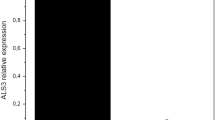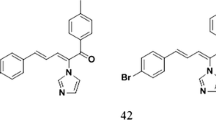Abstract
In a previous study, therapeutic activity of nikkomycin Z (NZ) in a model of invasive candidiasis did not appear to correlate with lesser activity in vitro (using classical MIC methods) with planktonic organisms. However, NZ potency was much greater assaying activity in vitro against germ tubes, the initiator of the invasive mycelial form of the fungus, as occurs in infected tissues. Synergy has been demonstrated for NZ and other drugs, notably fluconazole (the most commonly used drug against candidiasis), in planktonic testing, which correlated with results in vivo. This raised the question whether activity shown by NZ alone against germ tubes would be reflected in drug combinations, and even whether synergy testing against germ tubes might be a better correlate of synergy in future in vivo studies. We show in this study significant NZ synergy with fluconazole against germ tubes, for several C. albicans isolates, with testing in many drug ratios. This observation opens the way for further explorations of this method of susceptibility testing for synergy, and correlation with combination therapy against candidiasis.






Similar content being viewed by others
Abbreviations
- NZ:
-
Nikkomycin Z
- FCZ:
-
Fluconazole
- IC50:
-
50% Inhibitory concentration
- MIC:
-
Minimum inhibitory concentration in planktonic assays
References
Fiedler H-P, Schuz T, Decker H. An overview of nikkomycins: history, biochemistry, and applications. In: Rippon JW, Fromtling RA, editors. Cutaneous antifungal agents. New York: Marcel Dekker Inc.; 1993. p. 325–52.
Sass G, Larwood DJ, Martinez M, Stevens DA. Continuous dosing of nikkomycin Z against systemic candidiasis, in vivo and in vitro correlates. Mycoses. 2023. https://doi.org/10.1111/myc.13569.
Barnes JL, Osgood RW, Lee JC, King RD, Stein JH. Host-parasite interactions in the pathogenesis of experimental renal candidiasis. Lab Invest. 1983;49:460–7.
Ryley JF, Ryley NG. Candida albicans- do mycelia matter? J Med Vet Mycol. 1990;28:225–9.
Milewski S, Mignini F, Borowski E. Synergistic action of nikkomycin X/Z with azole antifungals on Candida albicans. J Gen Micro. 1991;137:2155–61.
Li RK, Rinaldi MG. In vitro antifungal activity of Nikkomycin Z in combination with fluconazole or itraconazole. Antimicrob Agents Chemother. 1999;43:1401–5.
Kim N-K, Park H-S, Kim C-H, Park H-M, Choi W. Inhibitory effect of nikkomycin Z on chitin synthases in Candida albicans. Yeast. 2002;19:341–9.
Hector RF, Schaller K. Positive interaction of nikkomycins and azoles against Candida albicans in vitro and in vivo. Antimicrob Agents Chemother. 1992;36:1284–9.
Andes DR, Safdar N, Baddley JW, Playford G, Reboli AC, Rex JH, Sobel JD, Pappas PG, Kullberg BJ; Mycoses Study Group. Impact of treatment strategy on outcomes in patients with candidemia and other forms of invasive candidiasis: a patient-level quantitative review of randomized trials. Clin Infect Dis. 2012;54:1110–22.
Clemons KV, Gonzalez GM, Singh G, Imai J, Espiritu M, Parmar R, Stevens DA. Development of an orogastrointestinal mouse model of candidiasis with dissemination to visceral organs. Antimicrob Agents Chemother. 2006;50:2650–7.
CLSI. Reference method for broth dilution antifungal susceptibility testing of yeasts—4th Edition: M27. Malvern: CLSI pub.; 2017.
Sabath LD, Lorian V. In vitro tests for antibacterial activity of antibiotics in combination. In: Bondi A, Bartola IT, Prier JE, editors. The clinical laboratory as an aid in chemotherapy of infectious diseases. Baltimore: University Park Press; 1977.
Lorian V. Antimicrobial combinations, chapter 9, in Antibiotics in Laboratory Medicine, p. 365–441, Lippincott Williams and Wilkins, Philadelphia, 2005.
Bonapace CA, Bosso JA, Friedrich LV, White RL. Comparison of methods of interpretation of checkerboard synergy testing. Diag Micro Infect Dis. 2002;44:363–6.
Elion GB, Singer S. Hitchings GH Antagonism of nucleic acid derivatives. J Biol Chem. 1954;208:477–88.
Doern CD. When does 2 plus 2 equal 5? A review of antimicrobial synergy testing. J Clin Microbiol. 2014;52:4124–8.
Stevens DA, Vo PT. Synergistic interaction of trimethoprim and sulfamethoxazole on Paracoccidioides brasiliensis. Antimicrob Agents Chemother. 1982;21:852–4.
Denning DW, Hanson LH, Perlman AM, Stevens DA. In vitro susceptibility and synergy studies of Aspergillus species to conventional and new agents. Diagn Microbiol Infect Dis. 1992;15:21–34. https://doi.org/10.1016/0732-8893(92)90053-v. (PMID: 1309690).
Stevens DA. Drug interaction studies of a glucan synthase inhibitor (LY 303366) and a chitin synthase inhibitor (Nikkomycin Z) for inhibition and killing of fungal pathogens. Antimicrob Agents Chemother. 2000;44:2547–8. https://doi.org/10.1128/AAC.44.9.2547-2548.2000.
Hoeprich PD, Finn PD. Obfuscation of the activity of antifungal antimicrobics by culture media. J Infect Dis. 1972;126:353–61.
The European Committee on Antimicrobial Susceptibility Testing, version 10.0, 2020.http://www.eucast.org/astoffungi/clinicalbreakpointsforantifungals/
Catz P, Green CE. Analysis of mouse plasma, brain and lung samples for nikkomycin Z. SRI International, Menlo Park, CA, 2020.
Mihalcea E, Licollari AA. Single oral dose range finding study followed by a 7-day repeated dose and pharmacokinetic study of NikZ in mice. Nucro-Technics Study no. 346295. Nucro-Technics, Scarborough, Ontario, Canada, 2019.
Mirdamadi K, Licollari A, Tan A. Evaluation of plasma concentrations of nikkomycin following administration to mice in drinking water. Nucro-Technics Study no. 374222. Nucro-Technics, Scarborough, Ontario, Canada, 2021.
Nix DE, Swezey RR, Hector R, Galgiani JN. Pharmacokinetics of nikkomycin Z after single rising oral doses. Antimicrob Agents Chemother. 2009;53:2517–21.
Clemons KV, Stevens DA. Efficacy of nikkomycin Z against experimental pulmonary blastomycosis. Antimicrob Agents Chemother. 1997;41:2026–8.
Sass G, Larwood DJ, Martinez M, Chatterjee P, Xavier MO, Stevens DA. Nikkomycin Z against disseminated coccidioidomycosis in a murine model of sustained release dosing. Antimicrob Agents Chemother. 2021;65: e0028521.
Larwood DJ. Nikkomycin Z-ready to meet the promise? J Fungi (Basel). 2020;6:261.
Hector RF, Zimmer BL, Pappagianis D. Evaluation of nikkomycins X and Z in murine models of coccidioidomycosis, histoplasmosis and blastomycosis. Antimicrob Agents Chemother. 1990;34:587–93.
Cheung YY, Hul M. Effects of echinocandins in combination with nikkomycin Z against invasive Candida albicans bloodstream isolates and the fks mutants. Antimicrob Agents Chemother. 2017;61:e00619-e717.
Kovacs R, Nagy F, Toth Z, Bozo A, Balasz B, Majoros L. Synergistic effects of nikkomycin Z with caspofungin and micafungin against Candida albicans and Candida parapsilosis biofilms. Lett Appl Microbiol. 2019;69:271–8.
Becker JM, Marcus S, Tullock J, Miller D, Krainer E, Khare RK, Naider F. Use of the chitin-synthesis inhibitor nikkomycin to treat disseminated candidiasis in mice. J Infect Dis. 1988;157:212–4.
Chapman T, Kinsman O, Houston J. Chitin biosynthesis in Candida albicans grown in vitro and in vivo and its inhibition by nikkomycin Z. Antimicrob Agents Chemother. 1992;36:1909–14.
Braun P, Calderone RA. Chitin synthesis in Candida albicans: comparison of yeast and hyphal forms. J Bact. 1978;135:1472–7.
Acknowledgements
The authors thank Marife Martinez for excellent technical support. This work was supported by the Foundation for Research in Infectious Diseases (FRID, Grant 8201), and from the David and Mary Larwood Family Charitable Fund. The funders had no input into the study design or interpretation of the results.
Author information
Authors and Affiliations
Contributions
All authors contributed to the study conception and design. Material preparation, data collection and analysis were performed by GS, DJL, and DAS. The first draft of the manuscript was written by DAS and all authors contributed to subsequent versions of the manuscript. All authors read and approved the final manuscript.
Corresponding author
Ethics declarations
Conflict of interest
Valley Fever Solutions promotes the development of NZ for therapy of coccidioidomycosis. D. J. Larwood is a principal in Valley Fever Solutions. The other authors have no relevant financial or non-financial interests to disclose.
Additional information
Handling Editor: Ferry Hagen.
Publisher's Note
Springer Nature remains neutral with regard to jurisdictional claims in published maps and institutional affiliations.
Rights and permissions
Springer Nature or its licensor (e.g. a society or other partner) holds exclusive rights to this article under a publishing agreement with the author(s) or other rightsholder(s); author self-archiving of the accepted manuscript version of this article is solely governed by the terms of such publishing agreement and applicable law.
About this article
Cite this article
Sass, G., Larwood, D.J. & Stevens, D.A. Synergy In Vitro of Nikkomycin Z with Azole Against the Invasive Form of Candida albicans. Mycopathologia 188, 949–956 (2023). https://doi.org/10.1007/s11046-023-00788-0
Received:
Accepted:
Published:
Issue Date:
DOI: https://doi.org/10.1007/s11046-023-00788-0




